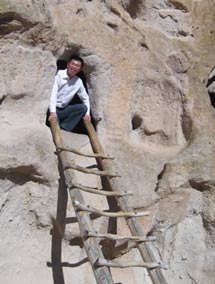
Handy Links
SLAC News Center
SLAC Today
- Subscribe
- Archives: Feb 2006-May 20, 2011
- Archives: May 23, 2011 and later
- Submit Feedback or Story Ideas
- About SLAC Today
SLAC News
Lab News
- Interactions
- Lightsources.org
- ILC NewsLine
- Int'l Science Grid This Week
- Fermilab Today
- Berkeley Lab News
- @brookhaven TODAY
- DOE Pulse
- CERN Courier
- DESY inForm
- US / LHC
SLAC Links
- Emergency
- Safety
- Policy Repository
- Site Entry Form

- Site Maps
- M & O Review
- Computing Status & Calendar
- SLAC Colloquium
- SLACspeak
- SLACspace
- SLAC Logo
- Café Menu
- Flea Market
- Web E-mail
- Marguerite Shuttle
- Discount Commuter Passes
-
Award Reporting Form
- SPIRES
- SciDoc
- Activity Groups
- Library
Stanford
Around the Bay
Jeffrey Lee to Receive Spicer Young Investigator Award
Jeffrey Lee, Assistant Professor in the Department of Laboratory Medicine and Pathobiology at the University of Toronto, has been named the 2010 recipient of the William and Diane Spicer Young Investigator Award. The award, created in honor of William Spicer, co-founder of SSRL and a pioneer in photoemission spectroscopy, and his wife, Diane, pays tribute to a young researcher whose work has benefitted from or is beneficial to the Stanford Synchrotron Radiation Lightsource or the worldwide synchrotron community.
"I'm very happy," said Lee. "It feels very nice to be recognized for my work."
The award, which is open to senior graduate students and those seven or fewer years into their professional scientific careers, will be presented on October 18 at the SSRL/Linac Coherent Light Source Users' Meeting. In turn, Lee will give a short presentation describing his recent research.
Until last month, Lee worked as a post-doc in the laboratory of Erica Ollmann Saphire at the Scripps Research Institute. There, he studied the Ebolavirus, which causes an untreatable disease that kills 50 to 90 percent of people who contract it. Using SSRL and other U.S. synchrotrons, Lee was able to uncover the structure of the Ebolavirus glycoprotein, which initiates the attachment and fusion of the virus and the host membranes, when it was bound to an antibody from a human survivor of the virus.
The work was especially challenging because glycoproteins are very difficult to crystallize. As a result, Lee and his colleagues needed to make over 140 different protein variants and grow over 50,000 crystals before finding one that would diffract the synchrotron light well enough to create images. But once they did, they were able to reveal the protein's structure, offering insight into why antibodies for the virus are so rare and into the very few sites to which an antibody can bind. This provides templates for the future development of immunotherapeutics and vaccines that may work against the virus. (More about this research can be found in this SSRL Highlight.)
"In addition, the methods we developed will be easily applicable for other groups and will probably streamline the structure determination process for a lot of these glycoproteins" in other viruses, Lee said.
Lee's letters of recommendation for the Spicer Award extol the novel ideas and methods he used to reveal the structure of the virus, parts of which refuse to crystallize and needed to be removed before the rest of the virus could be imaged with a synchrotron light source.
Now, as a newly minted assistant professor at the University of Toronto, Lee studies how retroviruses—including HIV—enter human cells, how the human immune system attacks them, and how the retroviruses subsequently try to avoid these attacks.
"Our lab studies a mixture of both structure and function," Lee said. "We will initially try to uncover the structures of these viral and human proteins, and then use this to guide our functional studies. It's great to be able to do this all in one lab."
—Kelen Tuttle
SLAC Today, August 30, 2010
